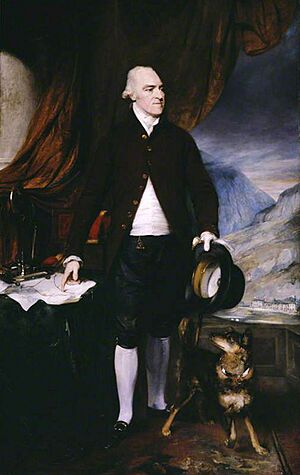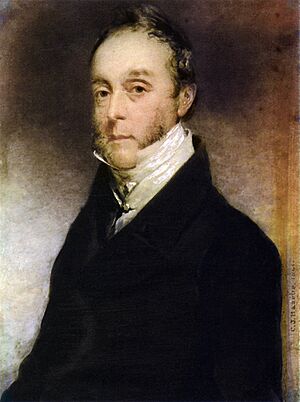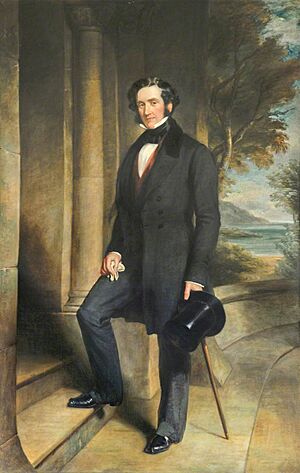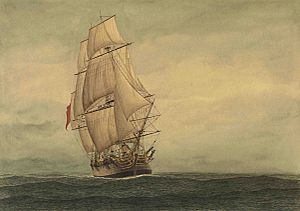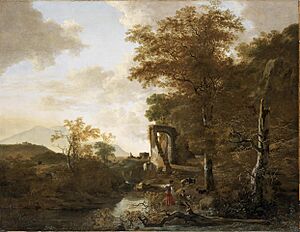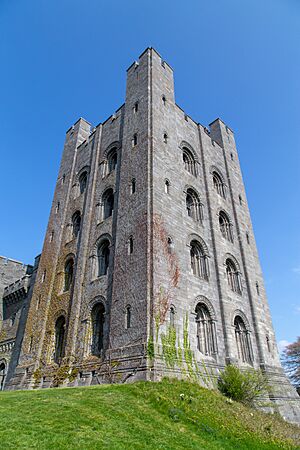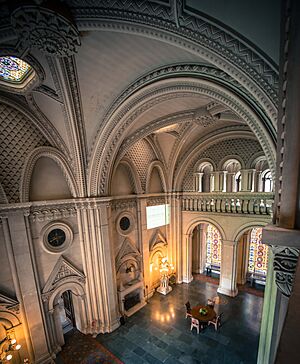Penrhyn Castle facts for kids
Quick facts for kids Penrhyn Castle |
|
|---|---|
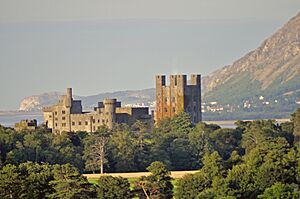
Penrhyn Castle – the keep to the right, the main block in the centre and the service wing to the left
|
|
| Type | Country house |
| Location | Llandygai, Bangor, Wales |
| Architect | Thomas Hopper |
| Owner | National Trust |
|
Listed Building – Grade I
|
|
| Official name: Penrhyn Castle | |
| Designated | 3 March 1966 |
| Reference no. | 3659 |
| Official name: Penrhyn Park | |
| Designated | 3 March 1966 |
| Reference no. | PGW(Gd)40(GWY) |
|
Listed Building – Grade II*
|
|
| Official name: Grand Lodge and forecourt walling | |
| Designated | 3 March 1966 |
| Reference no. | 3661 |
|
Listed Building – Grade II
|
|
| Official name: Walls and attached structures to terraced flower garden | |
| Designated | 11 March 1981 |
| Reference no. | 3 March 1966 |
|
Listed Building – Grade II
|
|
| Official name: Kitchen garden wall and attached outbuildings | |
| Designated | 24 May 2000 |
| Reference no. | 23375 |
| Lua error in Module:Location_map at line 420: attempt to index field 'wikibase' (a nil value). | |
Penrhyn Castle (Welsh: Castell Penrhyn) is a large country house in Llandygai, near Bangor, North Wales. It looks like a Norman castle. The Penrhyn estate started with Ednyfed Fychan. Later, in the 1400s, his family built a strong manor house here.
In the 1700s, Richard Pennant, 1st Baron Penrhyn owned the estate. He became very rich from his sugar plantations in the West Indies, where enslaved people were forced to work. He also made a lot of money from the slate mining industry in Wales. Richard Pennant used some of this wealth to rebuild the old house.
After Richard Pennant died in 1808, his cousin George Hay Dawkins-Pennant inherited the estate. From 1822 to 1837, he hired architect Thomas Hopper to rebuild the house. Hopper designed it to look like a grand Norman castle. George Hay Dawkins-Pennant also received a lot of money when slavery was ended in the British Empire in 1833.
In 1840, the castle went to Edward Douglas-Pennant, 1st Baron Penrhyn. He and his son, George Douglas-Pennant, 2nd Baron Penrhyn, continued to develop the slate quarries. They were against workers' unions, which led to big strikes, including one from 1900 to 1903. The family used the castle mainly as a summer home. They also collected many famous paintings. Important guests like Queen Victoria visited the castle. In 1951, the castle became part of the National Trust, a charity that protects historic places.
Penrhyn Castle is a very important building. It is known as Thomas Hopper's best work. It looks like a Romanesque Revival castle and is one of the most important country houses in Wales. The castle has a valuable art collection, with paintings by famous artists. Today, the National Trust is working to share the castle's full history, including its links to slavery.
Contents
History of Penrhyn Castle
Early Beginnings
In the 1400s, the Penrhyn estate was a large area of land owned by Gwilym ap Griffith. His family had received the land from Ednyfed Fychan, a powerful leader. Gwilym built a strong manor house and a chapel at Penrhyn, which became his family's main home.
From the 1600s to the 1700s
The Pennant family's wealth began in the late 1600s with Gifford Pennant. He moved to Jamaica and built large sugar plantations, where enslaved people were forced to work. His son, Edward, became a judge in Jamaica. By the late 1700s, the family had enough money to return to England and Wales. They managed their Jamaican properties from afar.
Richard Pennant, 1st Baron Penrhyn (1737–1808) took over the Penrhyn estate. He used his wealth from sugar to develop his Welsh estate. He greatly expanded the Penrhyn Quarry, which mined slate. He also built roads and Port Penrhyn to help export the slate. By the early 1800s, the Bethesda quarries became the world's largest slate producer. Richard Pennant hired Samuel Wyatt to rebuild the medieval house into a "castellated Gothic" castle.
Richard Pennant was also a Member of Parliament. He often spoke out against ending the slave trade. He was even the chairman of a group of politicians who wanted to keep slavery.
The 1800s and 1900s
George Hay Dawkins-Pennant (1764–1840) inherited the estate in 1808. He continued to develop the Penrhyn Quarry and opposed the end of slavery. He also continued building at Penrhyn. His plans for the castle were much bigger than Richard Pennant's. The castle that Thomas Hopper built for him between 1820 and 1837 is one of the largest in Britain. It cost a huge amount of money to build.
A German visitor in 1831, Hermann, Fürst von Pückler-Muskau, was amazed by the castle's size. He wrote that building such a castle, which only kings could do in the past, was now done by a "simple country-gentleman."
Edward Gordon Douglas (1800–1886) married George Hay Dawkins-Pennant's daughter, Juliana. He inherited the estate in 1840 and changed his name to Douglas-Pennant. He was made the 1st Baron Penrhyn in 1866. Edward collected many important paintings for the castle. His son, George Douglas-Pennant, 2nd Baron Penrhyn, took over in 1886.
The castle and estate passed to Lady Janet Pelham in 1949. In 1951, the castle and its land were given to the National Trust. This happened instead of paying a tax called "death duties" when someone inherits a large estate.
Penrhyn Castle Today
The National Trust has looked after Penrhyn Castle since 1951. They work to preserve the house and its grounds. They also make it a great place for visitors. In recent years, the Trust has been working to understand and share the castle's connections to colonialism and slavery. The castle's website states that they are "accelerating plans to reinterpret the stories of the painful and challenging histories attached to Penrhyn Castle."
Slavery and Slate at Penrhyn
The Castle's Link to Slavery
For many years, organizations like the National Trust did not talk much about slavery and colonialism at their properties. This began to change in the late 1900s. In 1995, an article highlighted Penrhyn's role in showing how profits from enslaved people helped Britain's economy grow.
In 2020, the National Trust published a report about the links between its properties and historic slavery. The report showed that George Hay Dawkins-Pennant received money for losing 764 enslaved people when slavery was abolished in 1833. This report caused a lot of discussion. Some people felt that history should not be changed. Others, like Professor Olivette Otele, pointed out that the castle's history often focused on the Pennants' improvements without mentioning where their wealth came from.
The murder of George Floyd and the Black Lives Matter protests in 2020 made the Trust even more determined to share these stories.
Exhibitions at the Castle
Penrhyn Castle has hosted several exhibitions about its connections to slavery.
- In 2007, an exhibition called Sugar and Slavery – The Penrhyn Connection opened. It included contributions from children in Jamaica, England, and Wales.
- In 2018, an art piece called 12 Stori by Manon Steffan Ros explored the Pennants' enslavement of African people.
- In 2019, two paintings of the Pennants' Jamaican plantations were on display. They showed sugarcane fields and a sugar factory. However, they were placed in a way that many visitors did not notice them.
- In 2020, a castle-wide exhibition called Beth yn y Byd / What a World: A Creative Look at Penrhyn’s Culture of Colonialism was installed. This exhibition used poetry and highlighted objects to help visitors understand the castle's history in a new way.
The Slate Industry
The Great Strike of 1900–1903 at the Penrhyn Quarry was the longest workers' strike in British history. It caused lasting anger. The strike happened because Lord Penrhyn refused to recognize the workers' union. Even today, some people in the nearby town of Bethesda still refuse to visit Penrhyn Castle because of this history.
In 2020, a special trail called Slate and Strikes opened in Bethesda to remember the 120th anniversary of the strike.
Art Collection
Penrhyn Castle has one of the best art collections in Wales. It includes works by famous artists like Canaletto and Richard Wilson. The collection once had a painting by Rembrandt, but it was sold in 2007. It is now on loan to the National Museum Wales.
Edward Douglas-Pennant started collecting most of the paintings in the mid-1800s. He was interested in Dutch landscapes, Spanish art, and Italian religious paintings. During World War II, many paintings from the National Gallery were stored at the castle to keep them safe.
The art collection remained with the Douglas-Pennant family even after the castle went to the National Trust. Over the years, some paintings have been given to the Trust. In 2016, about forty more paintings became part of the permanent collection.
Castle Design and Features
Overall Look and Style
Penrhyn Castle is one of the most admired mock castles built in the 1800s. It is known as a great example of the "Norman revival" style. The castle is very long, stretching over 450 feet. It has a tall tower (called a donjon) where the family lived, a main section with grand rooms, and a service area with stables. It is one of the largest houses in Britain.
Thomas Hopper designed all the main rooms inside in a rich Norman style. The castle even has special Norman-style furniture, including a one-ton slate bed made for Queen Victoria. She visited in 1859 but chose not to sleep in it! Some visitors found the castle a bit gloomy. One critic described it as "nightmarishly oppressive."
Hopper was a very flexible architect. He designed buildings in many different styles. Penrhyn Castle is usually seen as his best work.
Outside the Castle
The castle has three main parts: the donjon (family tower), the central block (state rooms), and the service wing. The castle is so long that you can't see it all at once. The builders kept parts of the original medieval house and an earlier castle in the design. The main material used is local stone, with fine limestone on the outside. The stonework is very high quality. The main entrance is through a long drive that leads to a gatehouse and a courtyard.
Inside the Castle
The Grand Hall
You enter the house through a low gallery, which leads into the Grand Hall. This hall is very impressive, with a high ceiling that looks like the inside of a church. It connects to the family rooms, the service wing, and the main state rooms. One critic said it was "about as homely as a railway terminus." The stained glass windows were made by Thomas Willement.
The Library
The library at Penrhyn is huge and very fancy. It has four large arches that look like wood but are actually plaster. The design of these arches is based on a real Norman church. The room has a billiard table made entirely of slate. It also has many bookcases and furniture designed by Hopper. The library still holds a good collection of books, even though some valuable ones were sold in the 1950s.
Drawing Room and Ebony Room
The Drawing Room was once the Great Hall of the medieval house. It has similar arches to the library but a lighter, more delicate style. This room was used by the women of the Pennant family. It has large, gold-colored mirrors. One visitor in the 1830s said one mirror was "the largest mirror ever made in this country."
The Ebony Room is named for its dark, shiny panels and furniture. Much of it is made to look like ebony.
Dining Room and Breakfast Room
These two rooms were used for meals. The larger Dining Room was for guests, and the smaller Breakfast Room was for the family when they were alone. They also served as galleries for many of the family's paintings.
The Grand Staircase
The Grand Staircase is considered one of the castle's greatest features. It took over ten years to build. It goes up the entire height of the house and is lit only by a window at the very top. It is made of different grey stones and has amazing carvings. It is seen as a masterpiece of Hopper's design.
Bedrooms
The main tower (keep) had bedrooms for the family and important guests. These rooms were arranged as suites on four floors. One room has the famous slate bed, which was meant for Queen Victoria. Many rooms have high-quality carpets and handmade Chinese wallpaper.
Service Buildings
Penrhyn Castle has many service buildings, even more than most large houses of its time. Inside the house, there were rooms like a butler's pantry, a servants' hall, and offices for the estate manager and housekeeper. The kitchen had separate rooms for different tasks. Many functions had their own towers, designed by Hopper to make the castle look even more like a fortress. These included an ice tower and a tower for housemaids. The stables also look like a fortress gatehouse. The estate also had a large farm and gate lodges.
Historic Building Status
Penrhyn Castle is a Grade I listed building. This means it is considered one of the most important historic buildings in Wales. It is a superb example of the Norman Revival style and is seen as Thomas Hopper's best work. Other buildings on the estate are also listed, including the Grand Lodge, other lodges, garden walls, and farm buildings.
Gardens and Grounds
The castle grounds are designed in the Victorian style. They feature special trees, rhododendrons, and many other plants. Queen Victoria and Queen Elisabeth of Romania each planted a conifer tree here. There is also a large farm on the estate. The gardens have a huge underground water tank, built in the 1840s, that could hold 200,000 gallons of water. Its purpose might have been for the castle's own fire brigade. The park is also a protected historic garden. The castle and its grounds are part of the UNESCO World Heritage Site for the Slate Landscape of Northwest Wales.
Other Attractions
Railway Museum
The Penrhyn Castle Railway Museum was a museum for narrow-gauge railways. The Pennant family's slate quarry was important in the development of these industrial railways. In 1951, a museum was created in the stable block. It displayed old locomotives, including Charles, one of the steam engines from the Penrhyn Quarry Railway. Many other historic British narrow-gauge locomotives were added to the collection. In 2024, the museum closed. The National Trust plans to open a new exhibition space called "Industrial Penrhyn" in the stable block. This new exhibit will focus more on items directly connected to the Penrhyn Estate. Most of the railway collection was moved to other museums in the United Kingdom.
Popular Culture and Events
In 2014, Welsh National Opera filmed part of an opera at Penrhyn Castle. The castle has also been used as a filming location for television shows. A parkrun event takes place in the castle grounds every Saturday morning. Runners can enter the grounds for free.
Images for kids
See also
- Castles in Great Britain and Ireland
- List of castles in Wales
- List of gardens in Wales


